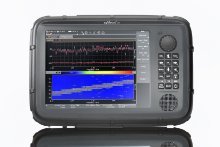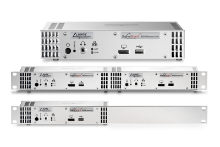How to Find RF Interference

How Do Operators Find RF Interference?
RF interference can be detected using an array of interference hunting devices. Signals and system interferences may be found using these tools and techniques.
Finding RF Interference is effective with the right tools and practices. RF interference hunting is needed when unexpected or illegal signals interfere with a network’s operation or system quality. In order to find RF interference, it is important to know why it is a necessary step to maintaining networks.

Note: Functions and steps might vary depending on the testing equipment.
To learn more about RF Interference Hunting, Direction Finding, Spectrum Monitoring, and more, check out our website solutions pages.
What Is Electromagnetic Interference?
Electromagnetic interference (EMI), also called radio frequency interference (RFI), refers to when radio signals interfere with a preexisting network system. These interferences can negatively affect the quality of a network that uses RF signals. Affected networks can include radios, telecommunications technology, the internet, and more. In order to maintain reception or productivity of a network, RF Interference Hunting Equipment is a necessity.Where Is RF Interference A Problem?
RF Interference can become a problem any time a network or device is being affected or influenced by unexpected or unauthorized signals. This can create problems with a network that need to be addressed. RF interference can also affect electrical and wireless devices.Industries Affected
- Telecommunications
- Electrical Engineering
- Aerospace & Aviation
- Military & Government
- Occupational Safety
- Non-Commercial Users
Radio Frequency Interference Examples
Some examples of RF interference include calls being dropped for seemingly no reason, spotty phone calls, poor radio quality, and low quality internet. RF interference hunting practices also are used to find unwanted signals, such as the RF signals from drones or possible military threats. It is also important to note that anything that uses radio signals can be at risk of RF interference.Cellphones
Low speed internet and disconnection or delay in a wireless network can also be the results of RF interference. Signal interference can affect cellphones, often resulting in choppy or degraded call quality. RF interference can also make calls drop completely. Signal interference can result in the quality of the sound or connection also lacking, or the device might also work slower in general.Military
In some cases, like in military operations, RF interference can be catastrophist if ignored. National security can be put at risk if military personnel cannot properly locate and override certain RF signals that are deemed as a threat. For example, enemy drones or aerospace operations are important signals to find in order to protect the country.Drones
Drones entering unauthorized airspace is also a key example because a drone is detected when aerospace personnel pick up the drone’s signal. Drones can be used to obtain illegal footage or deliver unwanted objects. Privacy and legality are key issues when it comes to regulating drones and the airspace they are allowed into. To combat the increasing number of drones that have the potential to enter unauthorized areas or airspace.
How To Detect Interference
In the past, signal interference has been hard to pinpoint, but interference hunting devices allow the operator to measure, map, and complete a number of tests in order to find interfering radio frequency signals. This task can be done with RF hunting devices and antennas. To start this analysis, technicians will often complete an in-depth drive test or manual direction finding.Drive Tests & RF Interference Mapping
Drive tests are a way for technicians to measure and map RF interference. Driving around and surveying the area in question, technicians use a direction finder or RF interference hunting device. This kind of practical testing allows operators to complete advanced mapping. This data can then be used to determine the right course of action.Narda SignalShark
The SignalShark is a RF Interference Hunting solution, functioning as a direction finder, spectrum analyzer, RF interference hunter, and more. Narda’s automatic antennas, handheld analyzer, and innovative software, allows for in-depth, real-time RF interference hunting.Features Of The SignalShark
Features of the SignalShark include real-time analysis, high-sensitivity, and a wide dynamic range. The Narda SignalShark 3310 has a real-time bandwidth of 40 MHz and a frequency range of 8 kHz to 8 GHz. The unit has a user-friendly interface and a touchscreen that is readable in both the sunlight and in darkness. The device the ability to detect, find, and map RF interferences, and with the 3310’s advanced applications and I/Q recording capabilities, the model is a precise and multifaceted device. Narda’s SignalShark was designed to work with any antenna and has high electromagnetic immunity. ATEC offers antennas from the SignalShark series to customers, along with the 3310 unit.Applications
- RF Interference Hunting
- RF Direction Finding
- RF Spectrum Monitoring
- Handheld Spectrum Analyzer
- Real-Time Spectrum Analyzer
SignalShark Modes
- Spectrum (Scan) Mode
- Real-Time Spectrum Mode
- Auto DF Mode
- Real-Time Streaming Mode
- Task Mode
Tasks & Views
- Spectrum
- Peak Table (of Spectrum)
- Spectrogram
- Persistence
- Level Meter
- Map
- Bearing
- Vita 49 FFT Streaming
- Vita 49 IQ Streaming
How To Fix Radio Frequency Interference
- Figure out the quality or signal problem that needs to be addressed.
- Choose your RF Interference Hunter.
- Find the source of the interference, using manual testing or drive test direction finding procedures.
- Analyze and take a closer look at the data for this unwanted signal.
- Determine the location of the interference.
- Find out what needs to be fixed to eliminate that interference.
- Turn off or override the source of the interference.
- If the problem is with your network/device, determine what needs to be repaired and then make those changes, using the appropriate equipment.
- Reevaluate the network’s quality and conduct further testing if necessary.
- Save data or results of future reference.
RF Interference Hunting Equipment Rentals
At ATEC, we want to help you find the best RF Interference Hunting solution for your work. Reach out to one of our rental agents today to learn more about ATEC’s RF interference hunting equipment rentals. ATEC offers precise and dependable products from industry-leading manufacturers like Narda Safety Test Solutions (Narda STS). We can also help you decide on the best equipment, based on your testing standards and requirements.To learn more about RF Interference Hunting, Direction Finding, Spectrum Monitoring, and more, check out our website solutions pages.

